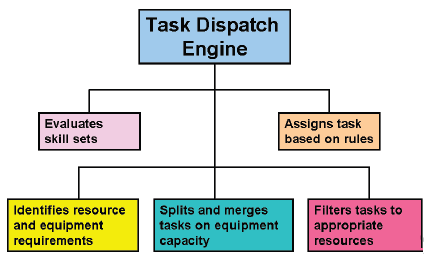Task planning is the release of work to the warehouse floor in order to optimally run the day-to-day warehousing operations. Once multiple tasks are created from the various task creation sources, they are placed in one single pool and released appropriately to the warehouse floor for optimal operation of the warehouse. Optimization is performed by task interleaving and resource-workload balancing.
Tasks are comprised of
- Demand pick tasks for sales orders, work orders, and replenishment.
- Inbound receiving and put away tasks
- Inbound-outbound hybrid cross-docking tasks.
- Inventory transfer tasks
- Inventory control related cycle counting tasks
You need to be able to plan the release of tasks in the warehouse on a day-to-day basis so that you can run operations optimally to minimize cost and maximize productivity. To do this, you need a single workbench that enables you to view the entire workload for one or more days. Using the Warehouse Control Board, you can query tasks based on multiple criteria, re-prioritize and interleave them, and release them to the warehouse floor in the form of task waves.
Task Types
Each task the system generates requires a System Task Type. Warehouse Management contains pre-defined system task types grouped by similar sets of features. When Warehouse Management creates a task, it assigns the System Task Type. You cannot edit a system task type for an existing task. The rules engine can use User Task Types to further classify System Task Types. The System Task Types are:
- Pick
- Put away
- Move order issue
- Move order transfer
- Replenishment
- Cycle count
You must set up at least one pick, one move order issue, and one replenishment task type. You can also define one cycle count task type if you want to dispatch cycle counts as tasks. Do not define more than one cycle count task type for the organization.
Task Type Rules
The Oracle Warehouse Management Rules Engine enables the system to assign task types to tasks. Like the picking and put away rules, task type assignment rules can be based on a variety of data, including the following:
• Unit of measure (UOM) defined for the pick line: for example, if the pallets need to be picked, the Task Type Assignment engine can dispatch tasks to the pallet pickers.
• Ownership of the material: for example, if the item belongs to XYZ company, and XYZ requires that their hazardous material be handled by a resource that has hazardous material handling skills, then the Task Type Assignment engine will dispatch tasks associated with XYZ's hazardous material handling requirements.
• Type of material being handled: for example, the Task Type Assignment engine might handle refrigerated material different than hazardous material Task type assignment rules are prioritized, based on their respective weights that you specify. For example, you might assign different weights for two rules to handle a specific tasks. In this case, the Task Type Assignment engine will execute the rule with the higher weight first.
Task Dispatch Engine

Whenever a new task is requested by the operator, the task dispatch engine handles the actual execution of a task. The task dispatch engine dispatches an appropriate tasks to a qualified operator. The task dispatch engine also handles exception management, and automatically triggers corrective actions whenever a discrepancy is recorded.
The task dispatch engine also performs the following functions:
• Identifies resource and equipment requirements for a particular task
• Evaluates skill sets
• Filters appropriate tasks to resources
The Task Dispatch engine also includes a set of predefined exception messages and transaction reasons that handle all of the generic exceptions during task dispatching, and will trigger a set of actions and workflows, based on these exceptions.

0 comments